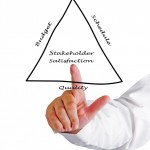
Each year, I work with hundreds of business people to prepare for the Project Management Professional (PMP)® exam. One of the most challenging topics in the course is Earned Value Management (EVM). Asking for a show of hands in response to the question, "who here actually figures out the Earned Value Management on their projects?" the response is, overwhelmingly, week after week, less than 10%. In an audience of 20 people, that is only one or two people at best.
Over the course of the year, let's say 750 people, about 75 are actively using EVM. Of those 75 people, 80% support large government contracts. When asked what they do with the data collected, they cite contract obligations. A comment or two usually follows where the person adds, "I don't do all of the earned value calculations. I have a team that gathers that data and gives it to me. I just put it into the customer briefing templates." I watch the group for signs of apprehension and see that about half the group has mentally moved onto another topic and shifted the conversation entirely.
Earned Value Management conceptually promises to help project managers better communicate the future effects of how a team is performing, reducing unpleasant surprises and better meeting stakeholder expectations. Who can't get behind those benefits? Most of us, however, are not blessed with an organizational culture of effective EVM implementation. Additionally, most project managers have neither the time, nor the motivation to attend weeks-long courses in EVM. Further, without the support of executive management to carefully plan all the work, allocate the necessary funds, track actual performance and, most importantly, take the necessary actions to bring performance in line with plan and revise inaccurate plans without career-limiting repercussions, a person would be fool-hardy to go it alone. So, what is the answer? Walk away? Business-as-usual?

Here is a brief overview of each of the five levels of the EVM3:
Level 1: Little or no earned value management (remember, this is 90% of the market represented by those organizations that invest in getting their staff credentialed in project management)
Level 2: A low-cost EVM system is in place allowing the team to monitor cost and schedule performance
NOTE: According to Stratton, these first two levels can be achieved with little investment simply by following a structured approach to defining project scope, assigning related costs and monitoring schedule performance, skills most businesses readily possess.
Level 3: The organization is fully compliant with ANSI standards for EVM. Many organizations new to EVM focus first on this level and become overwhelmed by the amount of work required to get here. The author recommends taking actions to implement levels one and two if time, circumstances, and resources permit. If your organization operates in an environment where ANSI compliance is the expectation, this is where you start.
Level 4: The quality of EVM data and the EVM system health are constantly monitored. This level requires a significant investment and commitment to go beyond operational compliance to ongoing, systemic training in EVM, a repository of historical EVM data and the creation of an Earned Value Process Group. Whew! All of this must be in place in order to reach...
Level 5: Optimizing implementation. Here, the organization creates projects to improve its EVM systems



 New Horizons
New Horizons
 Project Management Academy
Project Management Academy
 Six Sigma Online
Six Sigma Online
 Velopi
Velopi
 Watermark Learning
Watermark Learning
 Login
Login





 New Horizons
New Horizons
 Project Management Academy
Project Management Academy
 Velopi
Velopi
 Six Sigma Online
Six Sigma Online
 Watermark Learning
Watermark Learning